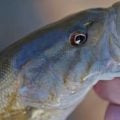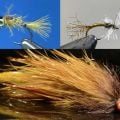“The Trout Diaries, A year of Fly Fishing in New Zealand” – January, Part 1
 HAVE YOU EVER BEEN on a fishing trip, long planned and much anticipated, where nothing seems to go right for you? You arse up just stepping out of the helicopter and give yourself a good one on the shin, a bruise that over the following days blossoms plump and purple like a Baccara rose. And that’s just the beginning.
HAVE YOU EVER BEEN on a fishing trip, long planned and much anticipated, where nothing seems to go right for you? You arse up just stepping out of the helicopter and give yourself a good one on the shin, a bruise that over the following days blossoms plump and purple like a Baccara rose. And that’s just the beginning.
You promptly trump this with another act, stepping on the loose end of a vine with one foot, with the other tripping over the noose you’ve thus created. You want to break the fall with your hands, but they are full of camping gear and heavy supermarket bags, and your backpack, well, it’s just big and inert enough to prevent a recovery.
Your companions help you up and give you puzzled looks. They are probably thinking: “What’s up with him? We all like a good drink but this is ridiculous. It’s not even lunchtime yet.” And you, too, wonder: what the hell is going on? Is this me or some nasty taniwha (Maori demon) whose home ground I have just entered and who clearly does not want me here?
Soon enough you’re convinced it’s probably both, because things get worse from there. On the river, you tangle up repeatedly, spook every trout you see, hook yourself with your own fly, and naturally it is one of only a handful in the fly box that have not been de-barbed.
To further compound the aggravation, your companions are having the time of their lives. That first night in the headwaters of the Rangitikei, one of the best and most remote of the North Island backcountry rivers, after we set up a camp of three tents and a large “living room” tarp in the forest clearing, Michel Dedual trotted off for an evening hunt and only ten minutes up the creek bagged a decent-sized sika deer. He brought it down, dressed and hung it inside a large mesh meat safe, then, going down to the creek to wash his hands, he spotted a fish rising in the camp pool. He ran up to get his rod, ran back, and hooked the six-pound trout with his first cast. In the pool below, I was with Marc, watching him hook and fight an equally magnificent rainbow. When night fell all I had to show for the day was a limp, a grazed elbow, and an increasingly foul mood.
But then we were all three back in the camp, and the fire, wine and good food worked their purifying wizardry. I stared into the flames, sipping another glass of red and thought: “Hey, anyone can have a false start, a bad day, and mine was just about over.” Earlier, I had poured some wine on the dry ground and the beech leaves that cushioned it, a kind of peace offering to the taniwha, if there was one. You never know, better safe than sorry. I certainly did not want to fight it for another day, or fight my ten-thumbs, two-left-feet self.
The upper Rangitikei, clear as spring water, snakes a contorted passage through the volcanic hills of the Kaimanawa Forest Park, east of the Tongariro River. The fishing here is hard and honest at the best of times, without added challenges or handicaps. You don’t come here to “clean up pools.” Every fish is a hard win, a major victory, and that’s providing you are at your best, assertive and sharp. Tomorrow, I promised myself, was a fresh start, a tabula rasa I would fill with perfect first casts and beautiful fighting fish. No pratfalls and blunders. No goof-ups. No excuses. I fell asleep with visions of rainbows racing each other to take those beautiful CDC dries Marc was tying.
I have to tell you about Marc. This, after all, was his trip, his story. He had travelled halfway around the world for these five days on the Rangitikei, and Michel, especially, did all in his considerable power to make them a memorable outing, at least as far as organising went. Once on the river Marc needed no help at all. As Pasteur said, “Good fortune favours the prepared mind,” and Marc Petitjean was more prepared than most. “If you define the problem, the solution is often obvious,” he told me that first night, apropos of nothing. “People often get pissed off with themselves, and they don’t know why. They never take time to precisely identify what bugs them. If they did, the remedy would be self-evident.”
These were wise words, but they were lost on me at the time.
Next morning, while doing the dishes on the riverbank, I scooped a large mayfly nymph—probably a Nesameletus—out of the river and into my stainless steel mug. It was hard not to. The aquatic insect life in the Rangitikei is so prolific that every time you dip a pot, plate or even cupped hands in the water you’re likely to capture one or more of the little beasts. No wonder the trout grow so large here.
I took the mug with the critter swimming in circles along the bottom back to the camp. Marc examined it closely, then set up his tying vise and whipped up a dozen or so imitations in three sizes, with tungsten heads and all-CDC bodies. Then he tied a handful of CDC dries, his generic mayfly pattern with an added white parachute post for high visibility. These would serve us as indicators, with the post made from the tail hair of the sika deer that was hanging from a nearby tree. Though we had brought with us enough flies to start a riverside tackle shop, in the end these two patterns were the only ones we would use. The Rangitikei fish either took them within the first couple of casts, or took nothing at all.
After Marc had his nymph pattern figured out, Michel Dedual, a Turangi fisheries scientist and the nemesis of red and sika deer, wild pigs and Taupo trout, took the mug back to the river, a walk of some 20 metres or so, and upended it, releasing the critter back into its home water, muttering something about la pauvre bête. It was a small gesture, but a telling one. I knew that, taniwhas or my own demons notwithstanding, I was in fine company.
We were fishing in French. This was only natural, since both Marc and Michel come from the French-speaking Swiss canton of Fribourg, and I once lived not far from there and have always been something of a closet Francophile—even when, after the Rainbow Warrior and Chirac’s follies at Moruroa, the simple act of buying ink cartridges for a French-made fountain pen in New Zealand was considered an act of national treason.
It is an obscure and oft-overlooked historical fact—a classic case of the butterfly effect—that if, at the decisive moment of the European colonisation of the Pacific, a certain Monsieur Langlois had driven his whaling ship Cachalot with just a little bit more haste, the way the French usually drive, the South Island could well have been not part of the Commonwealth but the Nouvelle-France of the South. Imagine that. We could have had topless beaches and chocolate from the Côte d’Or, bœuf braisé and coq au vin instead of pies and KFC, champignons instead of mushrooms, vineyards as thick as native forests and scholarships at La Sorbonne. The two islands would be like England and France, with the Cook Strait for the Channel. How different things could have been… how drôle! At times, I still feel a certain nostalgie for such scenario.
I have also always had a fondness for French fishermen and women because most of those I’ve met have in small or profound ways influenced my own way of fly fishing. I’ve yet to meet a French angler who was a hack, whose casting was less than masterly, whose fly box wasn’t a treasure trove of ideas and surprises. Whatever they do, the French usually do it with passion and abandon, and these they match with an overkill of skill and the best and most innovative gear money can buy. You’d be hard pushed to find a better example of all that than Marc Petitjean.
French born but living and working in Switzerland, Petitjean is the man responsible for the modern-day renaissance of CDC flies, both dries and nymphs, and especially the CDC-only flies which are one of his own contributions to our art and pursuit. When he is tying, his hands are a blur, a testimony to some 25,000 flies he has produced each year for the past decade, using up over a quarter tonne of Croupion de Canard (bastardised into Cul de Canard, cul being a slang word for the backside, where the duck’s waterproofing gland is located.) Think about it: a quarter tonne of CDC is a quack-load of ducks.
Apart from earning himself the title “the pope of CDC,” Marc has brought a Swiss-army-knife style of technology and engineering to the world and the fly-tying bench of anglers. His vise, vest and fly-tying accessories and tools, after you’ve seen them for the first time, instantly fall into a must-have category, if you’re lucky enough to obtain them. His bobbin holders, for example, as easy to thread as striking a match, are in such demand he cannot produce enough of them. And now, from first-hand experience, I can tell you he is as good an angler as he is an engineer and inventor. Watching him fish, laying out long and accurate casts and adjusting them just so with measured mends, is as pleasurable as doing it yourself. In my sorry asinine state on the Rangitikei, it was actually better than doing it myself.
Copyright © 2011 Derek Grzelewski. Excerpted from The Trout Diaries, A year of Fly Fishing in New Zealand, with permission from Stackpole Books.











